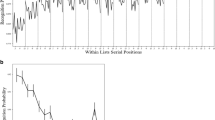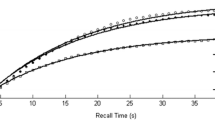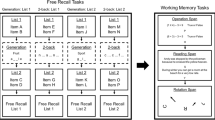Abstract
Hypotheses about the information processes impaired in diazepam-induced amnesia were tested by fitting the output from a computer simulation of list learning to observed serial position curves and to overt rehearsal protocols. Twenty-four subjects received an average weight-relative dosage of 0.18 mg/kg oral diazepam; 24 subjects received placebo. Immediate free recall of 16-word lists was examined at 2- and 8-s presentation times. Subjects receiving diazepam recalled significantly fewer words than placebo subjects (diazepam=6.77 ± 2.39 words; placebo=9.29 ± 1.42 words); their memory impairment was greater at the 8-s than 2-s presentation time. Tests of nonlinear regression models based on computer simulations of list learning performance were consistent with the hypothesis that diazepam reduces rehearsal capacity and disrupts the formation or utilization of contextual and inter-item associations. Among these causes of diazepam-induced amnesia, the disruption of contextual associations appears most important. The results further suggest that quantitative modeling of memory data may complement traditional methods of inferring relationships between brain processes and cognitive dysfunction in amnesic states.
Similar content being viewed by others
References
Block RI, Berchou R (1984) Alprazolam and lorazepam effects on memory acquisition and retrieval processes. Pharmacol Biochem Behav 20:233–241
Borowiak DS (1989) Model discrimination for nonlinear regression models. Dekker, New York
Brown G, Donenfeld W (1982) A mathematical learning theory analysis of Korsakoff rehearsal. In: Malatesha RN, Hartlage LC (eds) Neuropsychology and cognition, vol II. Martinus Nijhoff, Boston, pp 528–551
Brown GG, Rosenbaum G, Lewis R, Rourke B (1980) The effects of rehearsal rate on serial recall and Korsakoff amnesia. Neuropsychologia 18:185–191
Brown J, Lewis V, Brown M, Horn G, Bowes JB (1982) A comparison between transient amnesia induced by two drugs (diazepam or lorazepam) and amnesia of organic origin. Neuropsychologia 20:55–70
Buschke H, Fuld PA (1974) Evaluating storage, retention, and retrieval in disordered memory and learning. Neurology 24:1019–1025
Cermak LS, Naus MJ, Reale L (1976) Rehearsal and organizational strategies of alcoholic Korsakoff patients. Brain Lang 3:375–385
Christian J, Bickley W, Tarka M, Clayton K (1978) Measures of free recall of 900 English nouns: correlations with imagery, concreteness, meaningfulness, and frequency. Mem Cognit 6:379–390
Clark EO, Glanzer M, Turndorf H (1979) The pattern of memory loss resulting from intravenously administered diazepam. Arch Neurol 36:296–300
Ghoneim MM, Mewaldt SP (1975) Effects of diazepam and scopolamine on storage, retrieval and organizational processes in memory. Psychopharmacologia 44:257–262
Ghoneim MM, Mewaldt SP, Berie JL, Hinrichs JV (1981) Memory and performance effects of single and 3-week administration of diazepam. Psychopharmacology 73:147–151
Gillund G, Shiffrin RM (1984) A retrieval model for both recognition and recall. Psychol Rev 91:1–67
Huppert SA, Piercy M (1976) Recognition memory in amnesic patients: effect of temporal context and familiarity of material. Cortex 12:3–20
Mensik GJ, Raaijmakers JGW (1988) A model for interference and forgetting. Psychol Rev 95:434–455
Milner B (1966) Amnesia following operation on the temporal lobes. In: Whitty CWM, Zangwill OL (eds) Amnesia Butterworths, London, pp 109–133
Nelder JA, Mead R (1965) A simplex method for function minimization. Comput J 7:308–313
Phillips JL, Shiffrin RN, Atkinson RC (1967) Effects of list length on short-term memory. J Verb Learning Verb Behav 6:303–311
Press WH, Flannery BP, Teukolsky SA, Vetterling WT (1986) Numerical recipes: the art of scientific computing. Cambridge University Press, New York
Raaijmakers JGW (1982) A note on the measuremnt of primary memory capacity. J Exp Psychol [Learn Mem Cogn] 8:343–352
Raaijmakers JGW, Shiffrin RM (1980) SAM: a theory of probabilistic search of associative memory. In: Bower G (ed) The psychology of learning and motivation, vol 14. Academic Press, New York, pp 207–262
Raaijmakers JGW, Shiffrin RM (1981) Search of associative memory. Psychol Rev 88:93–134
Rich JB, Brown GG (1992) Selective dissociations of sedation and amnesia following ingestion of diazepam. Psychophamacology 106:346–350
Rundus D, Atkinson RC (1970) Rehearsal processes in free recall: a procedure for direct observation. J Verb Learn Verb Behav 9:99–105
Shiffrin RM (1970) Memory search. In: Norman DA (ed) Models of human memory. Academic Press, New York, pp 375–447
Shiffrin RM, Ratcliff R, Clark SE (1990) List-strength effect: II. Theoretical mechanisms. J Exp Psychol [Learn Mem Cogn] 16:179–195
Squire LR (1992) Memory and the hippocampus: A synthesis from findings with rats, monkeys, and humans. Psychol Rev 99:195–231
Tulving E (1983) Elements of episodic memory. Oxford University Press, New York
Woodard JL (1991) The dual nature of secondary organization in the selective and restricted reminding tasks: an application of the Search of Associative Memory model. (Doctoral dissertation, Wayne State University, 1991). Dissertation Abstracts International 52:2320
Author information
Authors and Affiliations
Additional information
Bold letters represent model parameters
Rights and permissions
About this article
Cite this article
Brown, G.G., Woodard, J.L. & Rich, J.B. Using a computer model to explore impairments of acquisition processes following ingestion of diazepam. Psychopharmacology 113, 339–345 (1994). https://doi.org/10.1007/BF02245207
Received:
Revised:
Issue Date:
DOI: https://doi.org/10.1007/BF02245207




